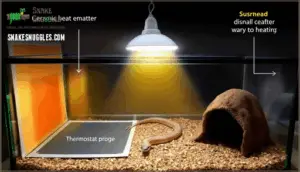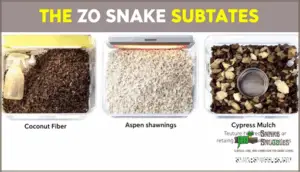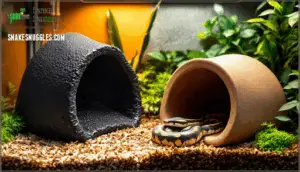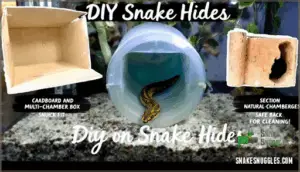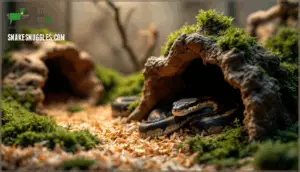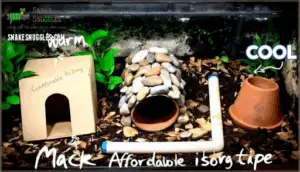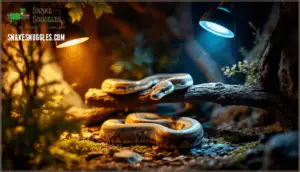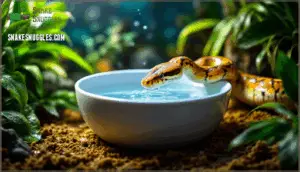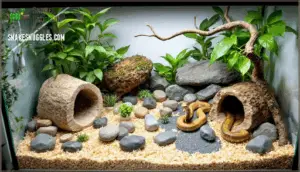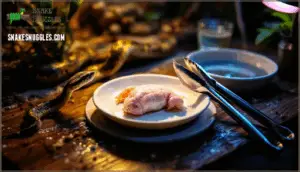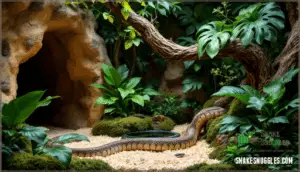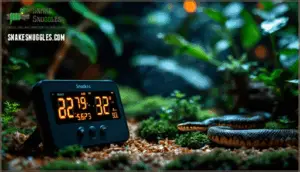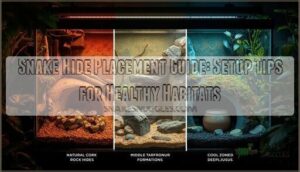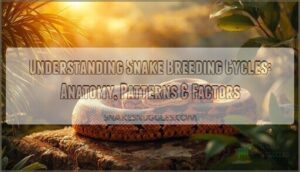This site is supported by our readers. We may earn a commission, at no cost to you, if you purchase through links.
 Most snake escapes happen in the first 48 hours after setup. That’s because new owners focus on making the cage look good while overlooking critical security features like properly fitted screen clips or testing door mechanisms under pressure.
Most snake escapes happen in the first 48 hours after setup. That’s because new owners focus on making the cage look good while overlooking critical security features like properly fitted screen clips or testing door mechanisms under pressure.
Your snake doesn’t need a Pinterest-worthy habitat—it needs a fortress that keeps it safely inside while maintaining the right temperature, humidity, and comfort levels.
Getting the accessories right from day one prevents the stress of a missing snake and guarantees your pet thrives. This checklist covers every essential item, from escape-proof locks to species-specific heating, so you can set up a secure enclosure that meets your snake’s biological needs without the guesswork.
Table Of Contents
- Key Takeaways
- Choosing The Right Snake Cage
- Heating Devices for Snake Cages
- Selecting The Ideal Substrate
- Providing Hiding Areas for Snakes
- Essential Lighting for Snakes
- Snake Water and Hydration
- Snake Safety and Enrichment
- Snake Feeding Essentials
- Snake Cage Decorations
- Snake Cage Temperature and Humidity Control
- Frequently Asked Questions (FAQs)
- What are the different types of snake cage accessories?
- How to choose a snake cage?
- How do I choose the best pet snake supplies?
- How do I choose a pet snake enclosure?
- What do you put in a snake cage?
- How do I customize my PVC snake cage?
- What should I have in my snake enclosure?
- What does a snake need in its cage?
- How to decorate a snake enclosure?
- What do you need to set up a snake tank?
- Conclusion
Key Takeaways
- Most snake escapes occur within 48 hours of setup because new owners prioritize aesthetics over critical security features like properly fitted locks, tested door mechanisms, and escape-proof seals—daily latch checks prevent the stress of a missing pet.
- Heating devices must create species-appropriate temperature gradients (typically 88-92°F basking zones and 75-80°F cool sides) using under-tank heaters, heat lamps, or heat mats paired with thermostats to prevent life-threatening overheating and thermal burns.
- Substrate selection directly impacts respiratory health and shedding success—cypress mulch works for humid environments, aspen shavings suit dry-climate species, while toxic options like pine, cedar, and contaminated soils cause metabolic damage snakes can’t detoxify.
- Hiding spots aren’t decorative but essential stress-reduction tools that support thermoregulation and natural behavior patterns—snakes without adequate hides develop chronic stress, refuse meals, and experience incomplete sheds at rates 60% higher than properly housed animals.
Choosing The Right Snake Cage
Your snake’s home is its entire world, so choosing the right cage isn’t just about size—it’s about security, comfort, and keeping your pet safe. The enclosure you pick will determine how easy it is to maintain proper temperatures, prevent escapes, and create a stress-free environment.
Let’s look at the main cage options and what makes each one work.
Escape-Proof Cages for Snakes
When you’re keeping snakes, your enclosure’s security matters more than you might think—around 50% of hobbyists report at least one escape. Choose cages with interlocking doors that pin together, PVC molded from a single piece, or tempered glass with strong locking mechanisms. These features work like a vault for your snake:
- Interlocking doors that make squeezing through nearly impossible when properly locked
- One-piece PVC construction with zero structural gaps to exploit
- Keyed locks or cage clips preventing both snake escapes and unauthorized access
Human error causes most escapes, so check your secure enclosure daily for proper latching and structural integrity. The cages utilize a revolutionary locking system to prevent escapes.
Glass Terrarium Setup for Snakes
Glass terrariums give you a clear view of your snake’s daily routine while offering solid structural security—but only if you set them up correctly. Choose glass thickness of at least 5mm and secure screen lids with locking clips to prevent escapes.
Your terrarium size should match your snake’s adult length—generally allowing it to stretch halfway around the perimeter. Position your thermometer at both ends to monitor temperature gradients, and place a water bowl large enough for soaking.
Plastic Reptile Cage Options
Plastic reptile cages offer a lightweight alternative that’s easier to move, holds heat more efficiently, and often costs less than glass options. You’ll find these plastic enclosures particularly useful when cleaning—just wipe them down quickly without worrying about heavy lifting. Consider these benefits:
- Weight Advantage: Move your snake’s home without straining your back
- Cost Efficiency: Save money without sacrificing an escape-proof cage
- Customization Options: Drill ventilation holes exactly where you need them
Plastic durability means your snake cage accessories stay secure for years.
Cage Security Tips
Even the most secure plastic cage won’t protect your snake if the lock fails or a curious child opens it by accident. Install clips or latches specifically designed for escape prevention—your snake’s talent for squeezing through tiny gaps makes proper Lid Security non-negotiable.
Childproofing Cages with sturdy locks prevents accidental openings while maintaining Emergency Access during health checks. Keep heating Cord Management organized to avoid creating escape routes, and regularly inspect your enclosure safety features.
These cage security tips guarantee your escapeproof cage stays that way, giving you peace of mind and your snake a secure home.
Heating Devices for Snake Cages
Snakes can’t regulate their own body temperature, so you’ll need to provide external heat sources to keep them healthy. The right heating device depends on your snake’s species, cage type, and the temperature gradient you’re trying to create.
Let’s look at the most common heating options and how to use them safely.
Under Tank Heaters for Snakes
Undertank heaters work like a warm stone in the sun—they create a cozy spot from below. These heating devices offer reliable warmth for nocturnal snakes who absorb heat through their bellies. Heat mats improve digestion and vitality in reptiles.
- Choose appropriate wattage: Most UTH models range from 4 to 24 watts based on your enclosure size
- Create a temperature gradient: Cover only one-third of the tank’s base so your snake can self-regulate
- Use thermostat control: Prevents dangerous overheating beyond 85°F and makes UTH safe
- Monitor species needs: Ball pythons and corn snakes thrive with heat mats, while arboreal species may need supplemental options
- Benefit from energy efficiency: These devices use 60% less power than overhead heat tape or rheostat systems
Heat Lamps for Snakes
Heat lamps bring warmth from above, mimicking the sun’s natural rays and creating a cozy basking zone your snake can move toward or away from as needed. Ceramic heaters deliver consistent heat without light, making them perfect for nighttime use.
You’ll want to position the lamp over one end of the cage to establish a proper temperature gradient—usually 88-92°F for the basking spot and 75-80°F on the cool side. Pay attention to lamp wattage since it varies by cage size: smaller enclosures need 50-75 watts, while larger setups may require 100-150 watts.
Always pair heating devices with a thermostat to prevent dangerous overheating, and install protective guards to avoid burns if your snake climbs.
Heat Mats and Heat Tape for Snakes
When your snake needs reliable belly heat without the bright glow of overhead lighting, heat mats and heat tape step in as quiet workhorses that warm from below. These heating devices deliver consistent warmth directly where your snake rests, making them ideal for species that prefer gentle, ground-level heat sources.
- Heat mat safety requires proper placement—always position mats outside the enclosure beneath glass or install them with adequate spacing to prevent burns
- Wattage requirements vary by tank size—smaller cages need 8-16 watts while larger setups may require 30-50 watts for proper temperature regulation
- Species suitability matters—terrestrial snakes benefit most from heat tape and mats compared to arboreal species that prefer overhead warmth
Using a Rheostat for Precise Temperatures
Think of a rheostat as your snake’s personal climate control—it fine-tunes heating devices with dial-based precision so temperatures don’t spike or drop unexpectedly. You’ll maintain temperature consistency while preventing thermal burns, which threaten reptile safety when heating devices overheat. Plus, accurate settings reduce wasted electricity, boosting energy efficiency—your wallet and your snake both win.
| Feature | Benefit | Safety Impact |
|---|---|---|
| Dial adjustment | Custom temperature control | Prevents overheating risks |
| Real-time monitoring | Instant heat regulation | Avoids temperature fluctuations |
| Energy modulation | Lower electricity costs | Extends heating device lifespan |
| Gradual calibration | Precise basking zones | Reduces thermal stress |
| Compatible design | Works with multiple heating devices | Simplifies multi-zone setups |
Selecting The Ideal Substrate
Your snake’s substrate isn’t just bedding—it’s a big part of their health and comfort. Different species need different substrates based on their natural habitat and humidity requirements.
Let’s look at the best options to keep your snake happy and your cage easy to maintain.
Cypress Mulch for Subtropical Snakes
For subtropical species like rainbow boas or emerald tree boas, cypress mulch acts as your first line of defense against respiratory infections and shedding problems.
This substrate excels at humidity control, holding moisture without turning into a swampy mess that breeds mold.
You’ll want a mulch depth of 2-3 inches so your snake can burrow when it needs privacy or temperature regulation.
Aspen Shavings for Dry Environments
Corn snakes, king snakes, and milk snakes thrive in arid conditions where too much moisture can turn a healthy habitat into a breeding ground for scale rot and fungal infections. Aspen shavings offer outstanding mold prevention since they don’t retain humidity like other reptile bedding options. Here’s why this substrate makes sense for your dry-climate snake:
- Low dust content minimizes respiratory irritation while allowing natural snake burrowing behavior
- Minimal impaction risks when ingested during feeding, unlike sand or fine particles
- Cost analysis shows aspen shavings deliver reliable performance without breaking your budget
Just monitor your snake cage accessories regularly to keep the substrate fresh and functional.
Coconut Husk Substrate for Snakes
If your ball python, boa constrictor, or rainbow boa needs a more humid environment, coconut husk substrate acts like a moisture reservoir that keeps conditions stable without turning soggy. This substrate selection for snakes offers excellent humidity retention while allowing natural snake burrowing behavior.
Here’s a quick cost comparison of safe substrates:
| Feature | Coconut Husk | Cypress Mulch | Aspen Shavings |
|---|---|---|---|
| Humidity retention | Excellent | Good | Poor |
| Mold prevention | Good | Moderate | Excellent |
| Impaction risks | Low | Low | Very low |
| Cost per month | $8-12 | $6-10 | $5-8 |
Spot-clean weekly and replace completely every four to six weeks to maintain your snake’s health.
Avoiding Toxic Substrates
When you compare coconut husk substrate to alternatives, don’t overlook the invisible threats lurking in some popular options. Pine and cedar bedding release Aromatic Hydrocarbons that damage respiratory systems, while garden soils may carry Heavy Metals or Pesticide Risks. Snakes face Metabolic Limitations—they lack the enzymes to detoxify many chemicals that mammals process easily. Selecting The Ideal Substrate means steering clear of these dangers:
- Pine and cedar woods that emit toxic oils
- Sand or gravel that causes life-threatening impaction
- Soils contaminated with fertilizers or pesticides
- Hardwoods like walnut that release harmful compounds
- Dusty materials triggering respiratory distress
Safe Alternatives include coconut husk substrate, aspen shavings, and cypress mulch—all proven options when you prioritize substrate safety.
Providing Hiding Areas for Snakes
Snakes need hiding spots to feel secure and reduce stress in captivity. In the wild, they spend much of their time tucked under rocks, logs, or dense vegetation to stay safe from predators.
Here’s a look at the different hide options you can provide in your snake’s enclosure.
Pre-Made Snake Hides
When you want to skip the DIY route without compromising on quality, pre-made hides are a veterinary-approved shortcut that’ll have your enclosure ready in minutes. Look for plastic or ceramic hideouts that match your snake’s size—material safety and cleaning ease matter.
Position these hiding spots at both warm and cool ends of your cage. Your snake gets the security it needs, and you’ll appreciate how simple maintenance becomes.
Creating Custom Snake Hides
Building your own snake hides from household materials can save money and give you exactly what your snake needs. Cardboard boxes, plastic containers, and cork bark work well as DIY hide materials—just cut an entrance sized appropriately for your snake.
Make sure hiding spots fit snugly so your snake feels secure, but leave enough room to turn around. You can create multi-chamber hides using connected boxes for added enrichment.
Keep aesthetics simple, focus on function, and avoid sharp edges. Cleaning custom hides is straightforward if you choose wipeable surfaces or disposable materials.
Importance of Hiding Areas for Snakes
Because snakes spend time hiding under rocks and logs in their natural habitat, recreating this environment at home isn’t optional—it’s essential. Hiding areas serve multiple critical functions: they provide security needs that reduce stress, assist with thermoregulation by offering temperature gradients, and create safe spaces during vulnerable shedding periods.
Without proper hiding spots, your snake may refuse meals or develop chronic stress-related health problems. Think of snake hides as your pet’s personal retreat where they can decompress and feel protected. These hiding places directly support natural behavior patterns that keep captive snakes mentally and physically healthy.
Affordable Hiding Area Options
You don’t need to spend a fortune on hiding spots—creative solutions can be just as effective as expensive commercial options. Cardboard boxes with entry holes make excellent DIY hides, while inverted plant pots offer sturdy, budget-friendly hideouts. Rock caves constructed from flat stones create naturalistic hiding areas. Even PVC pipe segments work perfectly for smaller snakes.
Focus on Hiding Spot Placement—position these budget materials on both warm and cool sides of your snake’s enclosure to support proper thermoregulation.
Essential Lighting for Snakes
Lighting isn’t just about seeing your snake—it’s about supporting their natural rhythms and overall health. The right bulbs can make a real difference in how your pet thrives.
Let’s look at the three main lighting options you’ll want to think about for your setup.
Full-Spectrum Bulbs for Snakes
Think of full-spectrum lighting as your snake’s personal vitamin factory—these specialized bulbs deliver the UVB rays that help reptiles process calcium and maintain strong bones, just like natural sunlight does in the wild. Not every snake species needs the same UVB exposure, so match the spectrum quality to your pet’s natural habitat.
Here’s what matters:
- Bulb lifespan: Replace every 6-12 months even if they still glow—UVB output fades before visible light does
- Proper placement: Position 12-18 inches from basking spots for best vitamin D production
- Reptile lighting basics: Choose bulbs labeled specifically for reptiles to guarantee appropriate UVB benefits
Quality full-spectrum bulbs aren’t optional—they’re preventive medicine.
Daylight Bulbs for Snakes
Daylight bulbs serve a different purpose than their UVB counterparts—they create visible light cycles that regulate your snake’s natural day-night rhythm without providing the specialized wavelengths needed for calcium metabolism. Most snake species thrive with 10-12 hour lighting schedules that mimic their natural photoperiod. Position daylight bulbs where they won’t overheat basking spots but still provide consistent illumination across your terrarium.
| Feature | Recommendation |
|---|---|
| Wattage | 25-75W depending on cage size |
| Light cycles | 10-12 hours daily for most species |
| Bulb placement | 12+ inches from basking areas |
| Replacement | Every 12-18 months for consistent output |
Choose reptile-specific daylight spectrum bulbs over household varieties—they’re designed to support natural basking behavior without disrupting your snake’s essential habitat comfort.
UV Lighting for Snakes
Full-spectrum bulbs deliver UVB rays that trigger vitamin D production—a major benefit for calcium absorption in many snake species. Research shows UVB exposure can increase vitamin D3 levels by over 500% in captive snakes.
Species variation matters: diurnal and arboreal snakes benefit most from lighting gradients with basking zones reaching 30-75 µW/cm².
Replace bulbs every 6-12 months since UV output drops by half over time, and maintain 10-12 hour cycles to support behavioral effects like natural feeding patterns.
Snake Water and Hydration
Water isn’t just something snakes drink—it’s a lifeline that affects everything from shedding to digestion. Your snake needs constant access to clean water, and getting this right makes a huge difference in their overall health.
Choose a water bowl that’s large enough for your snake to soak in completely. This isn’t just about drinking—soaking helps with shedding and maintaining proper humidity levels in their environment. The bowl should be sturdy enough that it won’t tip over when your snake decides to take a dip.
Here’s what matters most for Snake Water and Hydration:
- Change water daily to prevent bacterial growth and keep water quality high
- Watch for dehydration signs like wrinkled skin, sunken eyes, or difficulty shedding
- Use dechlorinated water if your tap water contains heavy chlorine or other chemicals
- Clean the bowl weekly with reptile-safe disinfectant to maintain a healthy water source
Fresh, accessible water bowls aren’t negotiable—they’re essential for keeping your snake thriving.
Snake Safety and Enrichment
Keeping your snake safe while giving it a fulfilling environment takes a bit of planning. You’ll need to think about preventing injuries, offering opportunities for natural behaviors, and supporting overall health.
Here’s what matters most when setting up a secure and enriching space for your snake.
Secure Lid for Snake Cages
A properly secured lid isn’t just recommended—it’s the single most critical barrier between your snake and an unwanted adventure through your home. Escape-proof cages for snakes require locking mechanisms that actually grip—not just loose-fitting screens. Look for lid materials like reinforced mesh or sturdy glass with clips rated for child safety, since curious kids and determined snakes share similar talents.
Cage security tips include checking latches weekly during lid maintenance and avoiding DIY options unless they’re genuinely strong. Providing a secure snake environment means treating every gap as a potential highway out.
Avoiding Sharp Objects in The Cage
Sharp edges don’t just scratch scales—they can cause injuries that lead to infection or scarring, especially when your snake’s exploring its cage at night. Inspect cage decorations before adding them to your snake cage. Run your hand over branches and rocks—if you feel splinters or rough spots, sand them down or skip them entirely.
Hidden dangers to watch for:
- Jagged rocks – Choose smooth stones with rounded edges
- Splintered wood – Select secure decor from safe materials only
- Sharp plant edges – Stick with nontoxic plants that have soft leaves
Providing Climbing Branches for Arboreal Snakes
For arboreal species like Green Tree Pythons, climbing branches aren’t just decorations—they’re critical snake cage accessories that enable natural behaviors and reduce stress. Your climbing structures should match your snake’s body width, with branch diameters between 2 and 5 cm providing ideal grip for most adults.
Natural branches with textured bark offer excellent climbing safety, reducing slips by 33% compared to smooth surfaces. Position branches both vertically and diagonally to mimic wild habitats, spacing them 15–30 cm apart. Secure placement is non-negotiable—unstable branches cause falls and injuries.
You’ll see the enrichment benefits quickly: arboreal snakes become 72% more active with proper climbing structures, spending over half their day perched and exploring. Choose between natural hardwood (oak, beech) or artificial branches made from textured resin—both work well, though synthetic options simplify cleaning and last longer.
Using UV Bulbs for Vitamin D
UV lighting is one of those accessories that often gets overlooked, but it plays a surprisingly important role in keeping your snake healthy. UVB bulbs help snakes produce Vitamin D3, which is essential for calcium absorption and bone health.
While not all species need intense UVB lighting, diurnal snakes benefit most from full-spectrum bulbs positioned 12–18 inches above basking spots. You’ll want to follow a consistent lighting schedule—usually 10–12 hours daily—to mimic natural day-night cycles and support your snake’s metabolic functions.
Snake Feeding Essentials
Getting your snake’s meals right is just as important as setting up the perfect cage. You’ll need to think about what type of prey works best, how big it should be, and when to offer it.
Let’s break down the feeding essentials that keep your snake healthy and thriving.
Choosing The Right Prey for Snakes
Feeding your snake the right prey isn’t just about filling the bowl—it’s about matching nutritional value to your snake’s needs. Live vs. frozen prey each have trade-offs: live prey stimulates natural feeding behavior, but frozen options reduce disease risk and injury concerns.
Consider prey size carefully, as meals too large stress digestion while undersized food lacks adequate nutrition. Research your species’ natural diet, then source quality snake food from reputable suppliers to guarantee safe, species-appropriate feeding methods that support long-term health.
Appropriate Prey Size for Snakes
Getting prey size wrong can stress your snake’s digestion or leave them underfed, so here’s how to get it right every time. Choose prey items with a width no larger than your snake’s widest body section to prevent regurgitation risks.
Here’s your feeding guide:
- Prey item width: Match the girth of your snake at its thickest point
- Feeding methods: Frozen-thawed prey reduces injury risks compared to feeding live
- Multiple prey items: Offer smaller snake food portions rather than one oversized meal
This approach keeps feeding schedules safe and stress-free.
Feeding Frequency for Snakes
How often you feed your snake directly impacts its growth, energy levels, and long-term health. Age considerations and snake species determine your feeding schedule—juveniles need meals twice weekly for rapid development, while adults thrive on weekly feedings. Monitor your snake’s activity level and health status, adjusting frequency during shedding cycles when appetite naturally drops.
| Life Stage | Feeding Frequency |
|---|---|
| Hatchling | Every 5-7 days |
| Juvenile | Every 7-10 days |
| Adult | Every 10-14 days |
| Senior | Every 14-21 days |
Match prey size to your snake’s girth for proper snake feeding and care.
Feeding Location for Snakes
Where you place your snake’s meal might seem like a small detail, but it can make or break your feeding routine. Here’s what works best:
- Feed in the enclosure to minimize touching stress and escape risks
- Use feeding containers only if multiple snakes share space
- Choose a designated area away from the water dish to maintain hygiene practices
- Match prey size to your snake’s girth for safe digestion
Reducing stress during feeding keeps your snake healthy and confident.
Snake Cage Decorations
Decorating your snake’s cage isn’t just about looks—it creates a healthier environment that mimics their natural habitat. The right decorations give your snake places to explore, surfaces to rub against during shedding, and mental stimulation.
Let’s look at safe decoration options that benefit both you and your pet.
Rocks and Wood for Snake Cages
Natural rocks and wood pieces transform your snake’s enclosure from a simple box into a functional habitat that aids both physical health and mental stimulation. Choose safe materials—smooth, non-porous surfaces that won’t harbor bacteria. Clean all rocks and wood thoroughly before adding them to your terrarium. Secure placement prevents injuries if your snake climbs or burrows underneath.
- Natural aesthetics create a calming environment that reduces stress
- Climbing branches encourage exercise and natural behaviors
- Enrichment opportunities keep your snake mentally engaged and curious
Live Plants for Snake Cages
Live plants bring your snake’s enclosure to life—literally. They boost humidity regulation by up to 30% through natural transpiration, creating a stable microclimate that benefits respiratory health. Bioactive benefits include oxygen production and ammonia reduction, making maintenance easier.
Choose hardy, non-toxic species like Pothos or Snake Plant for your terrarium accessories. These cage decorations provide enrichment value by encouraging natural exploration and reducing stress indicators. Studies show snakes housed with live foliage display 60% fewer incomplete sheds.
Plant toxicity matters, so careful species selection keeps your pet safe while enhancing your reptile accessories setup.
Non-Toxic Plants for Snakes
While live plants add beauty and function to your snake’s home, choosing non-toxic species is the most important decision you’ll make for your reptile’s safety. Safe plant species like pothos, spider plants, and assorted vines offer excellent cage decorations without toxicity risks.
Consider plant placement ideas that encourage natural exploration—these enrichment items reduce stress while keeping your pet secure. Regular cleaning of plant leaves prevents bacterial buildup, and verifying root system safety confirms nothing sharp hides beneath the soil.
Monitor watering considerations to maintain humidity without creating mold hazards in your snake cage decorations.
Securing Decorations in The Cage
After adding plants to your snake’s environment, you’ll need to fasten every decoration securely—unstable items can tip over and injure your pet or create escape opportunities. Decoration safety depends on proper attachment methods and weight considerations to prevent collapses.
Secure your snake cage accessories with these steps:
- Test stability by pushing firmly on climbing branches and terrarium accessories before adding your snake
- Use aquarium-safe adhesive or zip ties for lightweight enrichment items
- Verify material toxicity and cage decorations can’t shift during normal activity
Snake Cage Temperature and Humidity Control
Getting the temperature and humidity right isn’t guesswork—it’s about using the right tools to keep your snake healthy. You’ll need reliable instruments to monitor both heat levels and moisture in the enclosure.
Let’s look at the essential monitoring equipment every snake keeper should have.
Thermometers for Snake Cages
Accurate thermometers let you monitor your snake’s temperature gradient—essential for proper digestion and immune function. Digital models often provide better accuracy than analog options, though both work when calibrated regularly.
Place one thermometer on the warm side and another on the cool side for complete temperature control. Some keepers prefer digital thermometer-hygrometer combos or even remote monitoring systems for real-time alerts.
Verify calibration monthly to confirm readings stay precise, keeping your snake healthy and comfortable.
Humidity Gauges for Snake Cages
Once you’ve got the temperature dialed in, humidity becomes your next important checkpoint—and a reliable hygrometer makes all the difference. Digital hygrometers usually outperform analog models in gauge accuracy, though both require calibration tips every few months. Place your hygrometer mid-level in the enclosure—not directly under heat lamps or near water bowls—since placement matters for reliable readings.
Check your maintenance guide for simple calibration methods, making your humidity control stays precise. Proper humidity levels prevent respiratory infections and shedding problems, making temperature and humidity control equally critical for your snake’s health.
Ther
Think of thermostats as the invisible guardians that keep your snake’s habitat from swinging between dangerous temperature extremes. They work with ceramic heaters or infrared lamps to maintain stable temperature gradients between basking spots and cooler zones. Your thermostat control prevents overheating—a common cause of burns and stress in captive snakes.
- Pair heat mats with a rheostat for precise low-level warmth
- Position your thermometer near the basking spot for accurate readings
- Use heat lamps to create defined temperature gradients
- Keep the water bowl in the cooler zone to prevent excessive evaporation
Frequently Asked Questions (FAQs)
What are the different types of snake cage accessories?
Your snake’s survival hinges on six critical components: heating elements (under-tank heaters, heat lamps), substrate types (cypress mulch, aspen shavings, coconut husk), hiding options (pre-made or custom hides), lighting choices (full-spectrum UV bulbs), water solutions (soaking dishes), and secure cage decorations.
Each reptile accessory meets specific biological needs—thermal regulation, stress reduction, hydration, and vitamin synthesis—making your terrarium accessories list non-negotiable.
How to choose a snake cage?
Choosing the right snake cage starts with material safety and enclosure size. Glass terrariums offer excellent ventilation and visibility, while plastic options provide budget-friendly alternatives with a good cage lifespan. Always verify escape-proof seals and secure lids before purchase.
How do I choose the best pet snake supplies?
Start by identifying your snake species—temperature and humidity needs vary widely between ball pythons, corn snakes, and other reptiles.
Budget considerations and space requirements guide your choice of Snake Enclosure Supplies, from secure terrariums to essential items for snake habitat like substrate and hides.
How do I choose a pet snake enclosure?
Like shopping for a home where your snake will spend its entire life, enclosure selection demands careful attention to species-specific needs. Your snake’s adult size determines minimum cage dimensions—glass terrariums offer excellent visibility and ventilation, while plastic enclosures provide better heat retention and cost-effectiveness.
What do you put in a snake cage?
Your snake needs essential substrate like cypress mulch or aspen shavings, secure hides for stress reduction, a water bowl for hydration, temperature control devices like thermometers, and enrichment items such as climbing branches—all critical snake cage accessories.
How do I customize my PVC snake cage?
Customizing your PVC snake cage starts with understanding PVC size requirements for your species. Install lighting mounts and create ventilation options that promote airflow.
Add custom backgrounds to mimic the natural habitat, then secure climbing branches and hideouts.
A proper temperature gradient using adjustable heat sources facilitates thermoregulation, while species-appropriate substrate completes your enclosure design.
What should I have in my snake enclosure?
Your snake enclosure needs essential substrate for comfort, secure hides for stress reduction, a stable water source, proper heating devices creating a temperature gradient, and strong cage security.
Don’t overlook snake cage accessories like water bowls and appropriate snake hides—they’re key for your pet’s wellbeing.
What does a snake need in its cage?
Your snake’s cage needs substrate for comfort, a water bowl, hiding spots for security, and heating elements with temperature monitoring tools. Secure, escape-proof lids prevent escapes.
Choose snake cage accessories matching your species’ natural habitat, making sure appropriate cage size and substrate depth are used while avoiding sharp objects that could cause injury.
How to decorate a snake enclosure?
Decorating your snake’s home involves balancing aesthetics with function. Use climbing branches for exercise, multiple hiding spots for security, and non-toxic plants or naturalistic design elements.
Prioritize safe decor—nothing sharp or unstable—and arrange items to maintain proper temperature gradients while keeping substrate and water bowl accessible for easy cleaning and enrichment.
What do you need to set up a snake tank?
Setting up a snake tank is like building a home—you need the essentials for comfort and safety. You’ll need a secure enclosure with proper substrate depth, heating elements for a temperature gradient, hiding variety for security, a reliable water source, and appropriate lighting.
Don’t forget snake cage accessories like thermometers and decorations.
Conclusion
The best snake cage accessories checklist protects your pet even when you’re not watching. Security isn’t about spending more—it’s about choosing proven components that work together: escape-proof latches, species-appropriate heating zones, proper substrate depth, and dual hide spots.
Every accessory has a biological purpose, not just decoration. When your setup prioritizes function over appearance, your snake stays healthy, stress-free, and safely contained. That’s the difference between guesswork and reliable long-term care.
- https://www.customcages.com/interlocking-reptile-cage-doors.html
- https://www.reddit.com/r/VenomousKeepers/comments/1c1jhsi/best_escape_proof_enclosures/
- https://digitalcommons.usu.edu/cgi/viewcontent.cgi?article=1015&context=wdmconference
- https://www.youtube.com/watch?v=sg9zAWKF2-Q
- https://pmc.ncbi.nlm.nih.gov/articles/PMC8160691/

